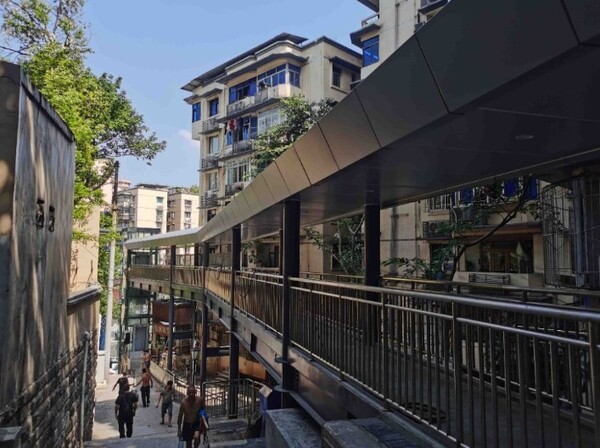By Shen Jingran, People's Daily
Southwest China's Chongqing municipality is a city built on mountains. The unique landform is an integral feature of this "mountain city" that delights both locals and tourists. However, it also means inconvenience for the 892,400 people with disabilities in the city.
In recent years, Chongqing has been continuously promoting the construction of a barrier-free environment to make life more convenient for people with disabilities or the elderly.
This includes the construction of ramps for wheelchair passage, the installation of connecting corridors and elevators, and the renovation of old residential areas for better meeting individualized needs.

"In the past, it was a challenge for me to go downstairs, but now it is convenient to go anywhere," said Peng Haiting, 64, who has been spending over 10 years in a wheelchair.
Suffering from polio since childhood, Peng relied on crutches to move at first. He could slowly walk on level ground, but had to rely on others to carry him when faced with stairs.
Peng lives in the Zhiyin'ge residential complex in Nan'an district. In 2000, he opened a shop about 1 kilometer from home. But he had to take a detour of 3 kilometers to reach it.
"I could have taken a shortcut, but there were many slopes that I couldn't climb on my own. If I didn't want to trouble others, I had to take a longer route," Peng recalled.
Over 10 years ago, due to the worsening condition, Peng started using an electric wheelchair with the assistance of the disabled persons' federation of Nan'an district.
Today, Peng's life has changed. In just a short 1-kilometer stretch from the complex to the street nearby, both the sidewalks and the road are connected by curb ramps, making it easy for Peng to move on the sidewalk. The sidewalks also have sufficient space reserved for wheelchair passage.

"Don't underestimate these curb ramps. They require careful planning," said Wang Shihong, an official with the housing and urban-rural development commission of Nan'an district.
According to Wang, the renovation of a barrier-free environment has strict norms and standards. There are 49 curb ramps in this renovated block, all of which have a slope of less than 12 degrees, and the height difference between the bottom of the slope and the road is no more than 10 millimeters.
Manhole covers are all paved with blind tiles, which reduces unnecessary detours, and the overall roadway slope has been made more gentle, Wang explained.
"Compared to cities in plain areas, the 'mountain city' faces greater challenges in constructing a barrier-free environment. Making it possible for people with disabilities to go wherever they want is not an easy task, but it has to be done," said Gong Yi, an official with the housing and urban-rural development commission of Chongqing.
In 2020, a renovation project for an old residential complex was launched in the Nanping neighborhood. Barrier-free facilities were not considered when these old buildings were built in the 1980s. As a large number of seniors and residents with disabilities live in the area, they hoped the project could make changes to accessibility.
According to Wang, all urban public buildings and residential complexes newly built in recent years in Nan'an district have taken barrier-free facilities into consideration, and the accessibility renovation in old residential buildings also remains a key focus.
"Before the renovation, we conducted household surveys in collaboration with community commissions to assess the living conditions of disabled residents in the areas. This ensured that while adhering to accessibility standards for public spaces, we could also accommodate personalized needs as much as possible," Wang told People's Daily.
Mu Qiang, a resident living in Xinxinglu community of Tiansheng neighborhood, Beibei district has also benefited greatly from the barrier-free renovation. Xinxinglu community, built in the 1980s, stretches along a small hill with significant elevation changes, and over half of its 1,300 residents are elderly.
"In the past, we had to climb 70-step stairs to go home from the street. Given my wife's knee problems, even with my assistance, she was not able to climb so many stairs, so she could only nestle at home all year round," Mu recalled.
During the renovation of Xinxinglu community, the installation of accessible ramps was a shared aspiration of residents.
"The design team initially proposed two relatively low-cost solutions, but one had too steep an incline, while the other had a ramp too narrow for wheelchairs to pass through," said Jia Shaobo, an official with the housing and urban-rural development commission of Beibei district.
The commission came up with a new solution - building connecting corridors and installing elevators along the streets. Although this option increased the cost by over 2 million yuan ($278,048) compared to the previous two plans, it was definitely worth it, Jia said.
"When it comes to renovating barrier-free facilities, we must make changes that satisfy the people," he added.
In recent years, Chongqing has been leveraging the renovation of old residential complexes as to promote the construction of a barrier-free environment. Over 370 service facilities for the elderly and childcare have been simultaneously renovated, along with more than 3,000 barrier-free facilities and over 4,700 elevators installed.
In terms of the construction of barrier-free systems on municipal roads, the pedestrian crossing facilities have been continuously improved in the downtown area, and curb ramps have been built in more intersections, entrances, and pedestrian crossings.


